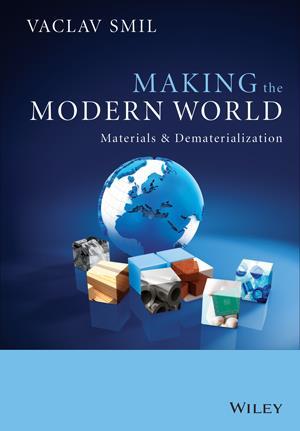Vaclav Smil
Wiley
2014 | 229pp | £24.95
ISBN 9781119942535

This book serves as a timely reminder of the importance of addressing society’s unchecked and imbalanced use of materials. It maps out why the use of materials exploded over the last century and how we got to where we are today.
The book has various interesting insights and covers developments for key material types: the section How materials flow reviews the methods to monitor and measure flow as well as the associated energy costs and environmental impacts, capturing the state of the art; Material outlook provides the latest thinking about efficiency in steel products. Through all this Vaclav Smil writes in a personable, accessible style, interacting with the reader and guiding them through his extensive knowledge of the subject.
However, the book’s purpose appears to be undersold; the rationale for dematerialisation may seem obvious for some but to others reducing demand for materials and ‘using less’ goes against the current business model for many industries and the desires of the wider public.
Dematerialisation’s benefits for climate change are also underplayed. If we explore the options for mitigating consumption by material providers, there are only limited opportunities to further improve energy efficiency and reduce emissions. Faced with achieving the high levels of decarbonisation required to prevent dangerous climate change, we find that mitigation on the part of consumers will play a very strong role – reducing our demand for energy and materials in society.
Viewed as an entire piece, the book can be heavy going. The sections are dense and would benefit from sub-headings and signposting throughout, as well as supporting diagrams, tables and figures. The introductions to the sections are welcome, but the book often reads like an academic literature review where the reader can go for pages without a section break. Having said that, it is the type of book you can dip in and out of and each page will provide something new in terms of facts and figures or novel processes from across industry.
A word of caution for those with an avid interest in the circular economy and material efficiency: it is worth reading Smil’s definitions of recycling and dematerialisation carefully, as the former captures re-use through to energy recovery, and the latter covers aspects of material efficiency beyond the elimination of particular materials.
Finally, it was disappointing that the Material outlook section did not cover the potential for the circular economy and provision of ‘material services’, as these are perhaps some of the key concepts that could yield positive results for dematerialisation. Notwithstanding this, the book does offer hope and ends with the author’s own solutions to the challenge of excessive material use.
Purchase Making the modern world from Amazon.co.uk












No comments yet